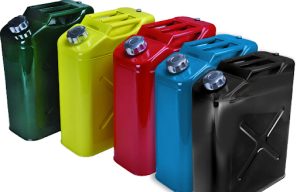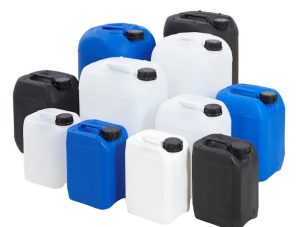In the field of plastic jerry can production, one of the most ambitious goals is to reduce expenses while maintaining the same level of quality. For the manufacturers of the plastic jerry can, the use of CaCO3-filler facilitates a reduction in the expenditure on materials as well as an improvement in strength of the resultant molded articles. Let’s go into the details of why this is important for manufacturers today. Find out in this report how this filler can optimize plastic jerry can manufacturing.
1. What Are Plastic Jerry Cans?
The plastic jerry can has become the most practical container required for storage and transportation of any liquid.The plastic jerry can was specifically designed for durability and lightweight properties. Originally manufactured for military usage, the plastic jerry can quickly become essential for storing chemicals, food, and fuel. The container can withstand impacts, corrosion, and harsh environmental conditions.
With the combination of fulfilling various qualities, it serves industrial as well as household applications. Being portable, stackable, and highly leak-resistant adds value to plastic jerry cans.

There are some materials commonly used in plastic jerry can manufacturing. High-density polyethylene (HDPE) is the chief among materials used in plastic jerry can manufacture because of its extremely convenient strength, chemical-resisting property, and flexibility. Other materials used are polypropylene (PP), polyvinyl chloride (PVC), and polyethylene terephthalate (PET) according to client’s specific requirements as to transparency, rigidity, or chemical resistance of plastic jerry can.
Nevertheless, there are a lot of obstacles bothering the manufacturers producing plastic jerry cans with ever-increasing raw material cost being on top of the list. Prices of polymer resins fluctuate as per the changes in oil prices, and supply chain disruptions. Big challenge is product quality maintenance through proper selection of materials while controlling production costs remains a big challenge.
CaCO3 filler masterbatch can offer a very effective solution for plastic jerry can production. This additive contributes to material cost reduction while improving the mechanical properties of plastic jerry can.
2. Understanding CaCO3 Filler Masterbatch

CaCO3 filler masterbatch is an important plastic additive that increases the cost effectiveness and functional performance of the plastic jerry can. CaCO3 filler masterbatch usually includes 3 ingredients: CaCO3 powder, polymer carrier, and some other additives.
In the present manufacturing industry, CaCO3 filler masterbatch has become an indispensable commodity in the current increases in the prices of raw materials. The ability of CaCO3 filler masterbatch is to cut raw material costs while producing a quality finished product that made it an ideal choice for worldwide plastic manufacturers. Additionally, a reputable supplier ensures high-quality calcium carbonate with fine particles, good dispersion, and no impurities that could impact performance.
3. How CaCO3 Filler Masterbatch Improves Cost-Effectiveness in Plastic Jerry Cans
Using CaCO3 filler masterbatch in plastic jerry can manufacturing offers multiple benefits. Here are some key advantages that explain why this additive is a game-changer for manufacturers.
3.1. Cost effectiveness
Using CaCO3 filler masterbatch helps reduce the portion of the expensive virgin plastic resin in plastic jerry can manufacturing. The reason is that a large amount of the high-cost polymer is replaced by calcium carbonate. Here, this enabled a considerable scope for reducing overall material costs.
Raw material prices like high density polyethylenes (HDPE) vary, depending upon market demand and prices of crude oil and supply chain disruptions. An end up using CaCO3 filler masterbatch will help manufacturers stabilize their production costs in the market. After applying CaCO3 filler masterbatch in the plastic jerry can, many companies found a huge reduction in material cost while maintaining the quality of the products.

3.2. Stiffness and Durability
The plastic jerry can meant for industrial chemicals have to be robust enough to withstand rough handling, stacking, and storage under different conditions. CaCO3 filler masterbatch increases the stiffness and the structural integrity of the plastic jerry can and makes them more resistant to deformation.
The more rigid plastic jerry, the better load bearing capacity and use life. This becomes meaningful in usages like chemical storage, where the containers would be expected to retain their shapes under the pressure. Many fuel storage companies using CaCO3 -enhanced plastic jerry cans report fewer complaints about warping and leaks. These jerry cans also retain their shape better.
3.3. Heat Resistance
The plastic jerry can is usually exposed to high temperatures during transportation and storage. The CaCO3 filler masterbatch is incorporated in plastic products to enhance heat resistance, thus preventing warping or softening under extreme conditions.
Heat stability becomes relevant where a plastic jerry can is to be used outdoors or in industries where heat exposure is rampant. Heat stability thus promises safe storage and transportation, maintaining shape and utility. For logistics companies, they mention that liquid detergents are transported in plastic jerry cans made with the CaCO3 filler masterbatch, which maintained their structure even after prolonged exposure to the sun. Any simple plastic jerry can, not made with this CaCO3 filler masterbatch, deformed in time.

3.4. Processability and Production Efficiency
The addition of CaCO3 filler masterbatch enhances the flowability of the molten plastic and contributes to molding the plastic jerry can easily. This means easy production where defects are few.
Fewer defect rates translate into faster production, less downtime for machines, less wastage of materials, and less energy consumed. This implies that the manufacturers could produce more plastic jerry cans in a lesser time without compromising any set standard. The manufacturers of plastic jerry cans elaborated that the use of the CaCO3 filler masterbatch had resulted in a dropping in cycle time and a reduction of defective products in its injection molding process.
3.5. Eco-Friendly and Sustainable Solution
The inclusion of CaCO3 filler masterbatch serves as a promising sustainable alternative to the plastic jerry can production. Its reduction in weight and lowering the percentage of virgin plastic used thus increasing the recyclability of plastic and thereby making disposal easier.
The path to sustainability by the industrial wayfaring to the extent of performance is the governing principle behind plastic reduction. Calcium carbonate is naturally available to some extent, and thus offers an even more sustainable option compared to 100% polymer-based production. The packaging company can successfully promote their products as eco-friendly to the attraction of environmentally conscious customers.
4. Case Study
Case Study: A Kenyan Manufacturer Achieved Cost Efficiency with CaCO3 Filler Masterbatch in Plastic Jerry Can Production

Context
This India-based company manufacturing quality HDPE jerry cans for various industries like chemicals, lubricants, and food packaging, felt growing pressure from raw material costs. Rising polymer resin prices had already begun reducing margins, making it difficult to offer competitive pricing. Moreover, their jerry cans suffer from brittleness and lack of required stiffness. The company is seeking solutions to reduce the production cost that will not compromise durability or performance on jerry cans.
Solution
After extensive consideration of economical options, the addition of CaCO3 filler masterbatch into the manufacture of plastic jerry can was agreed upon. EuP Egypt was engaged to make sure of the best CaCO3 masterbatch, which was specially designed to blend with HDPE resin. The replaced up to 30% of virgin HDPE with CaCO3 filler masterbatch.
Result
The outcome was astounding. On switching over to CaCO3 filler masterbatch, the company witnessed:
- Reduction in cost of raw material by 15% which in turn enhanced profit margins
- Enhanced production efficiency with a 10% faster molding cycle and reduced defects
- Stronger and more rigid jerry cans that reduced breakages by 20%
- Increased market competitiveness thus enabling better pricing without compromising on quality
- Customer complaints were also received regarding better durability in jerry cans concerning chemical and industrial liquid transport.
Conclusion
The use of CaCO3 filler masterbatch inputted in the plastic jerry can production, the Kenyan manufacturer has successfully reduced costs, increased the quality of product, and realized perfect efficiency. It would serve as a good case for other companies to follow in generality when manufacturing plastics, yet remaining competent in the market.
5. Why Choose EuP Egypt’s Filler Masterbatch for Plastic Jerry Cans Production?
EuP Egypt is one of the forefronts of the global filler masterbatch industry. A member of the EuP Group for 15 years, we are honored to be a trusted partner for plastic manufacturers worldwide.
One of the major advantages of EuP Egypt is raw material quality, employing good-grade Calcium Carbonate (CaCO3) coming from Egypt’s high-purity limestone. EuP Egypt utilizes superior material, assured the best quality of the plastic jerry can. Factories specialize in applying machinery with Germance technology, EuP Egypt guarantees the highest product consistency and efficiency for each customer needs. Here are some available top choice filler masterbatch:
- PE filler masterbatch: PE filler masterbatch serves as a cost-effective material solution in plastic processing as it replaces a portion of PE resin.
- PP filler Masterbatch: The excellent thermal properties of polypropylene (PP) filler masterbatch contribute to energy savings during production.
- Transparent filler masterbatch: significantly increases the transparency of many products including sheets, bags, and films.
- HIPS filler masterbatch: delivers high whiteness, excellent dispersion, and compatibility.

With an impressive annual production capacity of 180,000 tons, EuP Egypt has gained the trust of businesses from more than 95 countries worldwide by supplying quality raw materials at competitive prices.
Combining innovation, efficiency, and world competencies, EuP Egypt is a reliable partner for filler masterbatch solutions globally. Contact us now!





